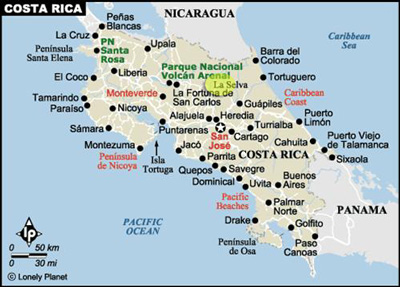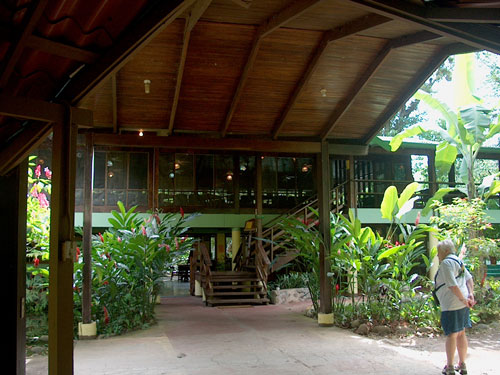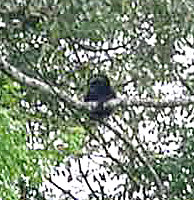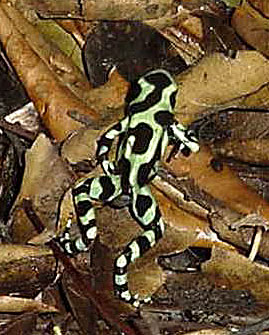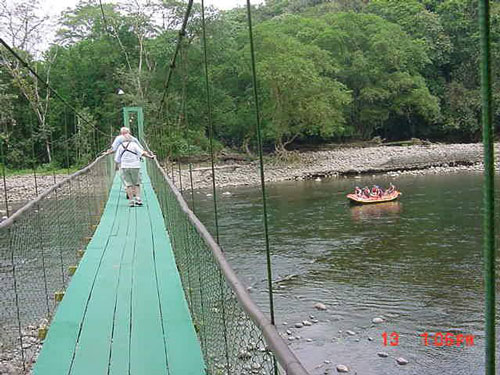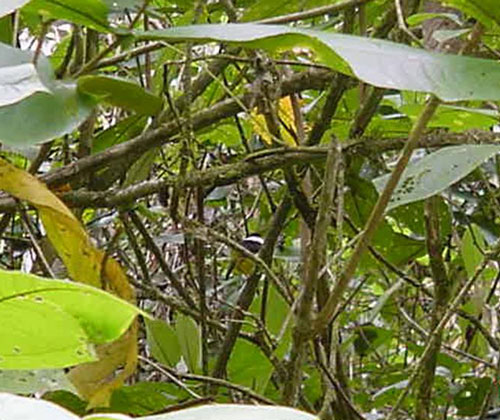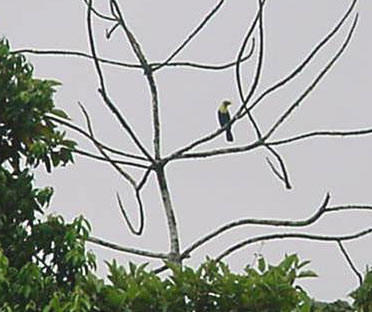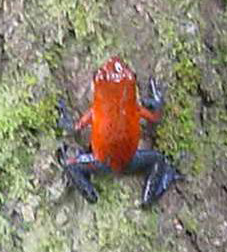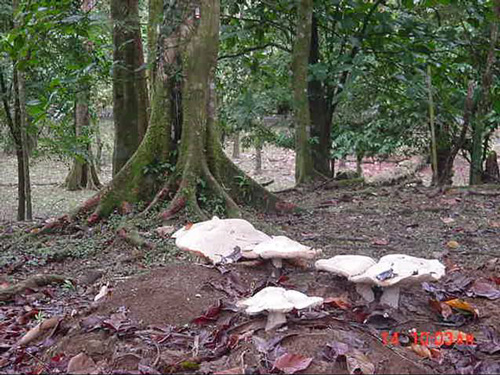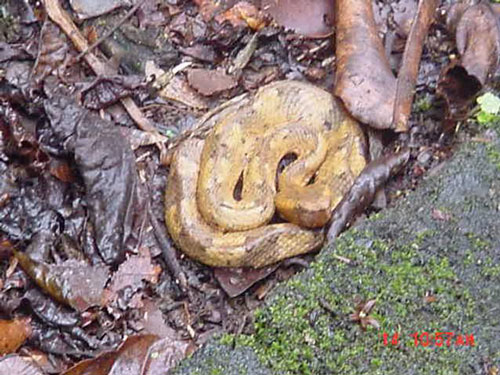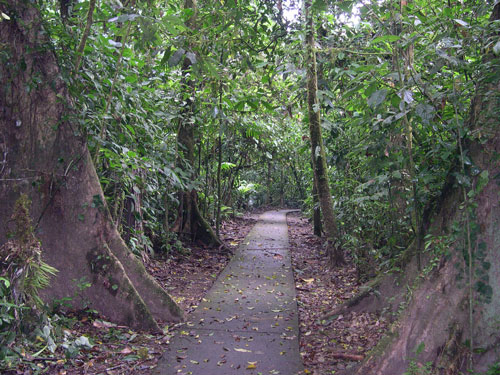|
|
Selva Verde Lodge
A few miles from the town of Puerto Viejo on the Rio Sarapiquí lies the
Selva Verde Lodge. It is one of the most famous headquarters for birders
in all of Central America. The lodge consists of some 40 rooms in 10
elevated cabins set upon 10’ high poles and connected by covered walkways.
The lodge is surrounded by lowland Caribbean jungle but is accessible by
paved road. A spacious dining room serves the 100 or so guests three meals
daily.
We checked into our spacious but non-air-conditioned rooms and then made
our way to the dining room. On the way, an Olive-backed Euphonia was
eating fruit at one of the many fruit feeders along the walkways. We
enjoyed an excellent lunch with many other guests who came there to bird,
raft, hike and study nature. As we left the dining room, Bryan pointed out
a Little Hermit (hummingbird) feeding on a flower. We heard there was a
White-collared Manakin near our rooms so I went to look for it. I could
hear the familiar wing snapping and other sounds but the bird hid back in
the trees. Milt, Dennis and Tom came down to join me and quickly saw the
bird bounce between a couple of branches—invisible from my angle. I’ll
have to try again.
The rest of the group joined us and we all walked across the road into a
secondary growth forest. A Mantled Howler Monkey was perched in a
tree—they usually move in packs so this one must have been an outcast. We
immediately started seeing new birds: Black-faced Grosbeak and a beautiful
Black-cheeked Woodpecker. Another "most wanted" bird flew in and landed on
a dead branch so we could get good views of it—a Collared Aracari, a
relative of the toucans with a large bill and bright colors. A Lesser
Greenlet had built a hanging nest six feet above the walkway. We got
better looks at Golden-hooded Tanager, that beautiful black, blue and gold
bird. A Long-tailed Hermit with its unusually long tail was feeding right
in front of us and a Red-footed (or Bronze-tailed) Plumeleteer (also a
hummingbird) let us see its red feet. Above the pond we found a hanging
nest like a miniature Oropendula nest. It belonged to a Scarlet-rumped
Cacique that we eventually found high in a nearby tree. We could not see
the scarlet rump from our angle. We began hearing the wing snapping of the
White-collared Manakin but could not draw it out even with a tape. A
White-necked Jacobin gave us a good look—lucky for me since I did not see
it well in Carara. Before we crossed the road back to our living quarters,
we heard a very noisy White-rumped Atilla and finally saw two of them in
branches just above our heads. There is a small butterfly enclosure on the
grounds and we walked through to see Blue Morpho’s close up.
As we walked towards our cabins, Dennis found a Green Poison Arrow Frog—a
tiny blue and green frog about an inch long. I was able to get a picture
just as he jumped. I guess some of the inhabitants of the area are able to
take the poison from the skin and put it on the tips of their arrows to
aid them in killing their prey. Before the light faded completely, we
walked out on the suspension bridge across the Rio Sarapiquí where we saw
Little Blue Heron and Ringed Kingfisher. A bird guide standing near us had
a large microphone and was sampling a piping sound from somewhere along
the river. As he played it back, a Sunbittern flew into view. We got quite
good views of this unusual species. No Tiger Herons tonight.
Dinner was very tasty—nothing really fancy but good. Our group is eating
the vegetables now—even lettuce. They advertise that they have their own
water source and that it’s free of bugs. As we walked back to our rooms,
someone asked us if we would like to see a snake. Sure. We followed them
to the open air reception area/lobby where they pointed a flashlight to a
place on the ground just over the railing. There was a 5’ long Boa
Constrictor of some type. A guest came across it on the walkway and she
became a bit upset thinking it was poisonous.
We tallied up our birds in Dennis’s room and then went to bed. We’ve seen
about 240 species by this time—about 140 are lifers for me. It rained hard
most of the night but the temperature was warm. A ceiling fan kept us
comfortable.
|
|
|
Selva Verde
We were up at 5:15 to prepare for a day of birding in perhaps the "birdiest"
place in Costa Rica—la Selva. Before breakfast, we checked out the
suspension bridge—no Tiger Herons again. The Sunbittern flew by and a
couple of Buff-rumped Warblers were just outside the dining hall by the
river. A female Green-breasted Mango (a hummingbird) was right by the
building. This hummer sometimes makes it up into Texas. We checked out the
walkway where some saw the White-collared Manakin yesterday and we all got
to see the bird this time. The staff permitted us to eat early so we could
get to la Selva as early as possible. We only have one shot there so we
wanted to not waste any time.
La Selva, about a 15 minute drive from our lodge, is the home of the
Biological Experiment Station where many scientists and students come to
study issues relating to the tropics. It is about 40 years old and has
quite a reputation for the diversity of its bird life. There are living
quarters for researchers and staff, a gift shop and a ten mile system of
cement trails through the forests. When stepped out of the van, we
immediately saw two Golden-hooded Tanagers at eye level about 5 feet away.
Wow!
Jimmy was assigned to be our guide for the morning. He is very
knowledgeable about the wildlife of la Selva. As he gave us instructions
near the gift shop, Blue-chested, Rufous-tailed and Violet-crowned
Hummingbirds zoomed around in the flowers. He pointed out a Band-backed
Wren in the base of a large antenna. Chestnut-mandibled Toucans and
Collared Aracaris ate fruit in a nearby tree. Birds were everywhere as if
sensing that people here mean them no harm. Passerinni’s Tanagers were
common. Some large green Mealy Parrots flew over. Gray-crowned Flycatchers
sat on wires. A Black-cheeked Woodpecker perched on a bare limb and a
Plain-brown Woodcreeper worked a trunk. Then a Rufous-winged Woodpecker
dazzled us with its bright red wings on a dull green body. A Fasciated
Antshrike played hard to see in a tangle of foliage. Great Kiskadees and
Social, Boat-billed, and Piratic Flycatchers seemed to be everywhere.
Jimmy found a Strawberry Poison Dart Frog, put it in a collecting bottle
and showed it to us. It was bright red with metallic blue legs and only an
inch long. It was making a call defending its territory—that’s how Jimmy
found it. A Rufous Mourner and a Cinnamon Becard flew in to give us good
views. A large Crested Guan flew up into a tall tree, its red patch
showing. We saw all of these birds while we stood for about an hour just a
dozen or so yards from the gift shop without even starting on the trails.
It rained lightly but soon stopped. We started across the bridge into the
extensive trail system of the primary forest. We saw a Brown-hooded Parrot
and a Green Iguana high in neighboring branches. In the forest, Jimmy told
us to watch carefully where we step—there are poisonous snakes in this
area.
The rain forest is quieter than one would think—some bird sounds but not
many. The wrens are the loudest. Jimmy recognized and eventually showed us
Stripe-breasted and Bay Wren in the undergrowth. White-breasted Wood Wren
was singing noisily but only Dennis and I were in the right spot to catch
a glimpse of it before it fled. We also found the now familiar
Chestnut-backed Antbird but no motmots which are so common here usually.
We found both Barred and Buff-throated Woodcreepers. We had hoped to see a
Latticed Trogon but they have evidently moved from this area deeper into
the bordering Braulio Carrillo National Park where they are difficult to
find. Jimmy knew of a place where a Great Potoo often hangs out—but it was
not there today. We saw some huge mushrooms growing around the base of a
tree—some of the caps about three feet in diameter. We heard the "Tap,
tap," of a large woodpecker. Only one woodpecker makes only two or three
taps at a time—the Pale-billed Woodpecker.
Coming across the bridge back into the lodging area area, Jimmy yelled, "Sungrebe!"
This is a difficult to find bird that we were surprised to see. It floated
with the current, disappeared under the bridge and re-appeared on the
other side for us all to get a look. From the end of the bridge we also
looked down into the foliage to see some very subtly-colored Dusky-faced
Tanagers. Their jerky movements were almost comical.
Jimmy led us a short way up another trail to where two orange-flagged
stakes bordered the cement. In between the stakes Jimmy had us try to tell
what we saw. Leaves, rocks. But as we looked more closely, we could
discern a coiled yellow and brown snake right next to the trail. It was a
Rainforest Hognosed Pit-viper about two feet long. It looked very much
like a large leaf. It was tightly coiled, triangular head at the center,
and ready to strike at any small animal or ankle that happened to pass on
the trail. Jimmy said it was quite poisonous—perhaps not as much as a
Fer-de-lance—but it would set you back some if it struck your ankle. He
said such snakes have an effective striking distance about ¾- th’s of its
body length away—about 18 inches. That explains why the staff members here
all wear knee-high rubber boots! This was the second poisonous snake they
had marked near the trail this morning. How many snake bites have they had
here? Jimmy said that in 40 years, they’ve had only 6 snake bite cases.
One staffer a few years ago walked in the dark to a friend’s cabin without
her boots. A large Fer-de-lance bit her in the leg and she was
hospitalized for two years. We all suddenly had much more respect for the
forest and its potential risks. How many of these guys had we passed this
past week without knowing the danger we were in?
We all relaxed in the shade provided by the reception area and got a
better look at the hummingbirds. Before we got into the van, we stood in
the parking lot searching the trees where we found lots of Masked Tityra
and then finally some Snowy Cotingas that Dennis had missed on previous
trips. We located a beautiful Violaceous Trogon with bright yellow belly
and black and white tail. Tom spotted a beautiful woodpecker—a
Chestnut-colored Woodpecker with a large crest—one of our favorites of the
trip.
We drove back to Selva Verde Lodge for lunch and then decided to return to
la Selva—at least the entry road to this great birding spot. We found
another Buff-throated Woodcreeper and heard its whistled call. A parakeet
high in a tree turned out to be Olive-throated Parakeet. Some Vaux’s
Swifts soared over. We were unsuccessful in making them into
White-collared Swifts. We decided that some black tanagers with white wing
patches were White-lined Tanagers meaning that similar birds we saw in
Carara were actually White-shouldered Tanagers. White-lined are in the
Caribbean slope forests and White-shouldered are on the Pacific slope.
This is a beautiful, serene and very birdy place. We could hear Little
Tinnamou in the undergrowth but could never get one to come out. Some saw
Golden-winged Warbler but it had fled into some leaves before we all saw
it. Bryan put the scope on it and all we could see was a tiny portion of
the bird’s head. Is that countable?
Our last day at la Selva—we arose at 5:00 and drove again to the entry
road. It was quieter than we expected for a spectacular, clear morning but
we saw many of the birds we saw yesterday plus a beautiful Yellow-tailed
Oriole and a familiar Gray Catbird wintering in the tropics. Some of us
plunged down through thick undergrowth to a trail on the side of a cleared
pasture area. (Others, remembering the snake from yesterday, elected to
stay on the road.) Here we found an elusive Rufous-and-white Wren in a
thick bush but we failed to locate a Giant Antshrike that Bryan and Dennis
found here last year. We again heard Little Tinnamou but failed to see it.
I have now heard four or five different Tinnamou species on trips to
Central and South America and have yet to see one!
Several other birding groups were working the same road. We shared
information and helped each other out. Employees at the center were
driving to work—they all waved to us—very friendly people are these Costa
Ricans. We were sad to leave this wonderful area and the comfortable Selva
Verde Lodge. We could envision spending a couple of weeks here and
enjoying every day of it. Only one more day left and still a lot to see up
at the much higher elevation near Poas Volcano.
|
